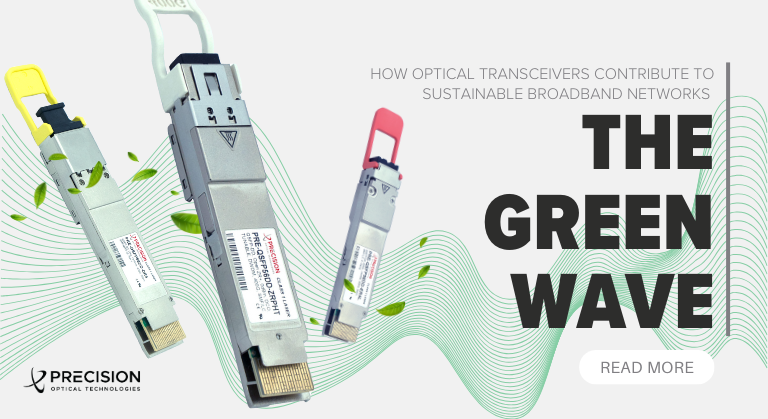
Embracing 5G xHaul: Reflecting on the O-RAN Global PlugFest

Fronthaul, backhaul, midhaul, xHaul transport — these are just some of the words keeping network engineers responsible for 5G deployments up at night. With carriers, MSOs and other network operators spending billions of dollars globally on 5G in search of return on investment, it’s a good time to say that there’s a way for the world’s engineers to rest easier at night, and it comes in the form of a tested and verified 5G xHaul transport solution that we were proud to be a part of during the O-RAN Alliance’s Global PlugFest 2021.
Ending Vendor Lock Through Open Standards and Interoperability
As many of you are already aware, the O-RAN Alliance’s mission is to reshape the world of Radio Access Networks (RANs) to be open, intelligent, virtualized and fully interoperable. That’s a mission that resonates with the Precision OT team in a big way.
In a previous blog, we talked about the advantages and challenges of building RANs in an open and disaggregated market. In the not-so-distant past, network operators looking to deploy RANs as part of a 5G deployment were constrained to the proprietary hardware and software solutions of a handful of vendors. Additionally, when it came to purchasing the transceivers necessary to link the different parts of their networks together, these same operators would often face exorbitant markups (50% or more) from larger, incumbent manufacturers. Thanks to the work of organizations like the O-RAN Alliance, the world of vendor lock has been changed forever.
The modern world of 5G network infrastructure fundamentally revolves around the disaggregation of the RAN (into radio units, distributed units and centralized units) as well as the industry-wide standardization of RAN elements to enable multi-vendor equipment and software interoperability. With multiple ways to deploy, split, link, and govern disaggregated RAN units as well as an increasing amount of choice around which hardware/software vendors to utilize, network operators can follow the technology path that best aligns with their goals. However, ongoing work around open architecture development, infrastructure virtualization, and the creation of standardized interfaces is leading to a new emphasis on the 5G transport network. Here’s how.
5G is More than the RAN: The Need for xHaul Transport
The phrase “fiber deep” best describes the ongoing evolution of 5G networks. It’s no secret that 5G will demand significantly more fiber and more optical transceivers all along the way from the small cell sites to the core network. From a transport perspective, coupling 5G’s densification requirements with the innovative RAN architectures made possible through open standards will lead to a significantly increased number of nodes across the entire network. These nodes will need the high speed connectivity that only wireline fiber offers. And that’s just to enable 5G to live up to its lofty performance goals.
Yet, 5G networks aren’t just about raw performance. They also need to reliably support use cases that leverage emerging technologies like the Internet of Things , augmented/virtual reality, artificial intelligence and machine learning. The network slices that will make this possible require dynamic traffic steering and flexible service separation across the entire 5G network, from fronthaul to backhaul and beyond. For many carriers and other operators, an added challenge exists: supporting converged 4G/5G transport technologies. The solution to all these individual challenges? The holistic approach of 5G xHaul.
Deploying a 5G network in a world full of logistical challenges requires holistic thinking beyond the RAN. In fact, the RAN is just a part of the entire fiber-deep transport infrastructure that will be needed to deliver 5G properly. As a 5G transport solution, xHaul incorporates the wireless and wireline technologies of fronthaul and backhaul into a common transport network. To put it another way, 5G xHaul interconnects all aspects of the RAN to the core. For today’s carriers, MSOs and other operators, implementing an xHaul transport solution can be tricky as it requires a high level of automation and orchestration across the entire network to meet the stringent latency, timing and synchronization requirements of 5G.
The Critical Piece of the 5G xHaul Puzzle: Precision OT’s PlugFest Experience
That’s where the O-RAN Global PlugFest proved very exciting for the world of 5G rollouts. The Precision OT team was selected to be a part of a test designed to prove whether third-party optics could work as part of the O-RAN Alliance’s 5G xHaul transport solution. The results were fantastic. The set of optics we contributed achieved full interoperability with the other vednors’ equipment. In fact, the Precision OT team was not onsite for the tests — we simply provided the transceivers. It was a perfect demonstration of the “plug and play” benefits that we bring to the industry.
Following the laboratory testing, we have been able to leverage our equipment in similar fashion with some of our larger European customers. For its part, the O-RAN Alliance announced that the Global PlugFest “demonstrated the strength of the O-RAN ecosystem and its global drive towards open and intelligent Radio Access Networks.” Here at Precision OT, we strongly believe that getting 5G xHaul right is mission-critical for today’s network operators and that transceivers will continue to be the critical pieces needed to enable it. As optical network specialists, we not only have the equipment that can contribute to successful 5G xHaul deployments, but we also have the expertise to help you create custom solutions as required.
Although the technical results of the PlugFest are currently a “for members only” deal, contact us for even more information on the future of 5G, 5G xHaul, and what we can do for you. Our engineers are standing by!






